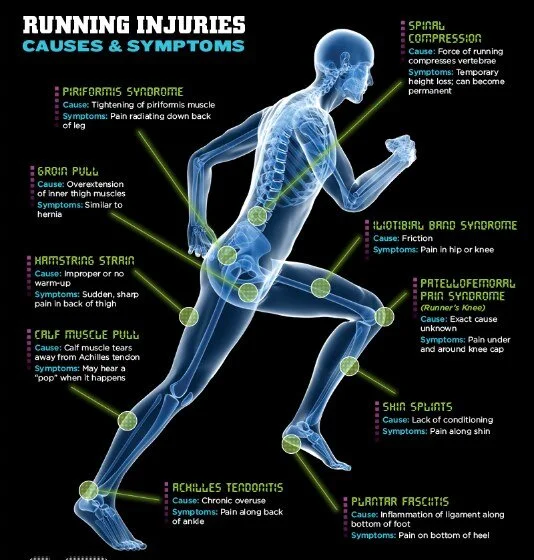15 Key Strategies To Cope With A Sports Injury
written by Lois Warden (D1 athlete at Bryant University)
AS AN ATHLETE, IT IS INEVITABLE AT SOME POINT IN YOUR CAREER THAT YOU WILL EXPERIENCE AN INJURY.
There is no way around that fact. The best thing you can do is accept that it is part of the process, take the time you need for your body to heal, and get back out there!
Despite the attempt to continually prevent these injuries and however much we wish they would go away, often they will still occur. Injuries are both mentally and physically demanding of any athlete regardless of how many injuries they have experienced and how mentally strong of an athlete they are.
The key to dealing with a sports injury is using the best coping mechanisms possible to keep yourself mentally and physically healthy. Some athletes are a lot better at managing their injuries and taking an active role in staying motivated even when in rehabilitation. For more ways to stay motivated, please look at previous posts. The athletes with more motivation who remain involved in their active rehab, tend to have fewer negative thoughts and less concern about when they will return to their regular routine of practicing and competing. It is important not to rush into training after an injury or be too hard on yourself, lowering your self-esteem. This only makes it worse. Again, accept the fact that it happened and deal with it. You got this!!
It is well known that medical professionals understand how to aid athletes to cope with injuries and are much more prepared to do so. They can successfully employ coping strategies that will assist the athlete to return to competition faster.
Coping is how one invests their conscious effort to solve any personal or other problems they may be experiencing in their life to minimize or deal with stress and conflict within their life. A coping mechanism is an adaption to environmental stress that essentially enhances control over behavior or gives comfort to the individual experiencing it. As stress and anxiety are personal, different people respond to other things in their way, especially in a high-stress situation such as dealing with an and it can depend on a variety of different things, i.e. severity of the injury, mental toughness, resilience, and gender.
HOW ATHLETES COPE WITH THEIR STRESSES AND ISSUES OF AN INJURY INEVITABLE DETERMINES THE OUTCOME THEY WILL HAVE WHEN RETURNING TO THE SPORT.
There is a variety of coping strategies that can be implemented for successful recoveries, such as avoidance coping, emotional focused coping, and problem-focused coping.
PROBLEM-FOCUSED COPING
Problem-focused coping is aimed at resolving the stressful situation or event or altering the source of the stress. This focuses on changing the situation itself in contrast to dealing or managing the emotions that are associated with the problem instead. This strategy is seen as more positive because the athlete will take a more active role in their recovery, and it displays problem-solving actions. An element of this strategy is goal setting, which is extremely important when managing an injury. If you do not set goals, it is easy to lose what you are working for and working towards and easy to become demotivated. Once you have become demotivated, it is tough to get going again. Goal setting is essential in the athlete's recovery and journey to get back to what they love doing and are passionate about.
Keeping that love and fire alive is what will help in the stages of recovery before they can get back to competing and training as they once were.
Some goals that athletes can focus on that are specific and obtainable could be rehabilitation goals, dates to return to practice, and being more robust and better than before their injury. Each goal they achieve is a step closer to being where they were and gives them a purpose. Aim to focus on getting healthy rather than feeling sorry for yourself and getting lost the injury.
EMOTIONAL-FOCUSED COPING
Emotional focused coping is when the athlete attempts to control their emotional response to the situation at hand, so in this case, their injury. In this coping strategy, they must take the positives out of the problem and tackle the injury head-on. This could include going to treatment for the injury or working around what you cannot do. For example, succumbing to foot injury you can focus on core and upper body strength while you are in recovery, so you are still actively working on yourself and your training despite it not being what you are used to.
This strategy aims at diminishing the negative emotions due to stress.
Some techniques of this, not necessarily related to sports, include watching television, venting, reaching out to friends, family and coaches and medical staff. By doing this, the athlete is not only coming to terms with the situation but reaching out to build a robust support system around them for the foreseeable future.
AVOIDANCE COPING
This strategy is often deemed harmful as it involves avoiding the issue at hand. It is a coping tactic that consists in attempting to separate themselves from the problem rather than dealing with it. The problem with this, especially during an injury, is that the athlete may avoid doing anything related to the injury, which includes treatment and working actively to ensure they are fit and strong for their return. If you stop treatment and training altogether, it is difficult to know when you will eventually return. Your progress in training will not be where it once was, and your confidence will be diminished. This could lead to demotivation and loss of love for the sport itself. Although for some, this strategy works, it is not the most typical nor effective strategy for athletes to take when injured.
FACTORS THAT CAN AFFECT COPING STRATEGIES
Mentally tough athletes are more likely to use positive coping strategies to get through their injuries and are more likely to use the problem-focused methods rather than avoidance.
An athlete who is mentally tough and strong often has a different outlook on their injury than those that are not as mentally strong.
For example, a mentally strong athlete who experiences an injury may see it as manageable and something they can workaround. Whereas, in contrast, an athlete who has more anxiety and stress may see this injury as disastrous and the end of their career. These types of athletes are more likely to use the avoidant strategy to deal with their injury, so they do not have to face what they are going through. I feel as though the first injury is the worst and is difficult for any athlete to manage regardless of their mindset. The first injury is always tricky as you have not had to manage it before whereas if you have had more than one injury, you learn ways to cope with it and can implement the strategies you used before.
THE RESEARCH FOR COPING WITH A SPORTS INJURY
Research shows that athletes use each of these strategies mentioned above to cope with their injury. Problem-focused coping tends to be the most desirable way to cope with injury as athletes need to cope with the problem at hand for their rehabilitation and return to sport. It is common for the coach to encourage this type of coping strategy for their athlete as they want them to get the right treatment necessary to continue training as soon as possible. This strategy is favorable with athletes because they can take a mental part in the rehabilitation process.
The athletes that tend to use this strategy often set goals that are strong, reachable, and involve rehabilitation. This will allow you to return from the injury sooner, with less damage, and more mentally stable.
Emotional focused coping is also popular; however, it does not always have positive outcomes as there are ways it can lead to negativity. Reaching out to family friends and coaches are a big part of coping with an injury because a strong support system is essential, especially on days when the injury can feel like too much to deal with individually. The support system that an athlete has around them both during and outside of injury is essential for the athlete’s mental health and mindset, specifically when coping with injuries. Some of the other ways you can implement emotion-focused coping are where the problems arise. If you obsess overdoing one thing, such as watching tv or playing video games, you can get stuck in a cycle of it and it can be disconnecting from those around you who are trying to help. It is okay to take a break and forget about the injury, yet it is also essential that there is a balance. You can take a avoid the injury for some time, let your body rest and heal, but you need to be willing to tackle the problem once again.
Finally, the avoidance strategy has a lot of negative connotations and often has adverse outcomes. Primarily when this is used at the beginning of the process, it can lead to a bad results. Although this strategy, in some instances, can be successful when used in combination with the other positive strategies. It can help the athlete take time away from always dealing with it, and it can be a positive distraction. It is also a way to work on other aspects of their life that is important such as school or work and personal development.
15 Key Strategies to Overcome Sports Injury:
Do low impact activities such as riding a bike or running hills
Isolate the injury and work different body parts
Focus on different skills - for instance, if you have a leg injury and cannot run, work on your reaction time with simple hand raises coming out of blocks.
Hop in the pool for some aqua training
Set clear and realistic goals
Visualize a healthy version of yourself and take steps to get there.
Be positive and optimistic
Focus on the present
Allow yourself to be emotional
Accept help and support
Take control
Learn about your injury
Maintain your fitness while injured, work around your injury
Do not let the injury control you
Be willing to get back out there
HELLO
MY NAME IS COACH NICK
FOLLOW US ON INSTAGRAM
Want To Read More?






















We’ve heard it all. Every excuse in the book to skip a post-workout stretch. However, static post-workout stretching is equally as important to training as the formal workouts themselves and should be made a regular, consistent part of any track & field athlete’s training plan.